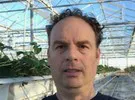 Gerard van den Brand is growing strawberries in a 16,500 square meter greenhouse is Altforst, the Netherlands. Being the chairman of the National Strawberry Committee and part of many research groups, he's also a fervent proponent of making the strawberry cultivation more sustainable and communicating about it. "We have to create a positive image to the customer. We are doing pretty well, but every now and then the strawberry is still reprimanded. Even when this is not fair we will have to keep presenting ourselves positively by showing the consumer that we are really doing a good job."
Gerard van den Brand is growing strawberries in a 16,500 square meter greenhouse is Altforst, the Netherlands. Being the chairman of the National Strawberry Committee and part of many research groups, he's also a fervent proponent of making the strawberry cultivation more sustainable and communicating about it. "We have to create a positive image to the customer. We are doing pretty well, but every now and then the strawberry is still reprimanded. Even when this is not fair we will have to keep presenting ourselves positively by showing the consumer that we are really doing a good job."
Second cultivation
The Elsanta second cultivation happens on racks with gutters. The strawberry plants are grown in bins with peat substrate on top. For cultivation, Van den Brand uses rainwater from a 4,000 m3 basin. "When the basin falls below a certain water level, we add well water which is first processed by the reversed osmosis device. We made good use of it during the hot, dry summer last year."
The drain water from the UV sanitizer, taking care of the pre-filtration, is processed by a cloth filter. The filtered water is then transported to the waste water silo. The cloth with organic dirt is disposed with the company waste. Van den Brand: "Because of the low drainage in strawberry cultivation, the investment in the UV sanitizer is not immediately profitable, but we have to meet the strict Dutch regulations that states all drain water has to be collected. For smaller companies, it is much more profitable to join a treatment collective."
Closed cultivation
The strawberry cultivation is completely closed. The drain water from the cultivation is collected in the waste water silo. At a certain level, the drain water is processed by the UV sanitizer and stored in the clean water silo. After mixing with rain water, this water can be used for cultivation. The strawberry grower uses all the water before the end of the cultivation.
Van den Brand is a recognised zero drainer, and has a declaration from the government. "We grow in a closed loop and drain nothing. The residue of fertilizers and crop protection agents is reused."
Get a positive image
"If you have to use something, you have the option of a limited number of means", Van den Brand says about the decreasing number of chemical crop protection agents being allowed. "We try to hold on to these, but that is not easy with the rules becoming increasingly strict. We have to look for solutions in biology, and in proper green means for control."
"In the strawberry cultivation, we are working a lot with biological crop protection, but we do not yet have the success we want, because we are dealing with a low average day temperature of 13 degrees Celsius in strawberry cultivation. Strawberries like a warm day and a cold night. This makes the average day temperature lower than, for example, tomatoes."
Source: Glastuinbouw Waterproof
